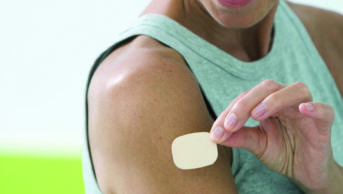
Alamy.com
The management of menopausal symptoms often presents a clinical challenge to prescribers. This could be because of concerns about breast cancer risk and initial data from the Women’s Health Initiative trial in 2002, which reported an increased risk in cardiovascular disease (CVD) and possible early harm in women receiving combined oestrogen and progesterone[1]
. This resulted in reduced prescribing of menopause hormone treatment (MHT) in the UK. Subsequent follow-up data from the same study in 2013 showed no detrimental effect on CVD; therefore, with careful consideration of risks and benefits, there are now around one million women in the UK using treatment (including MHT) for their symptoms[2]
.
Menopausal oestrogen deficiency is associated with irregular periods and multiple other symptoms — the most common being hot flushes and night sweats, vaginal dryness, mood changes, sexual dysfunction (including loss of libido), memory and concentration changes, headaches, joint and muscle complaints. Around 80% of women will experience symptoms, lasting an average of four years[2]
.
In healthy women over the age of 45 years with menopausal symptoms, menopause and the perimenopause can be diagnosed without laboratory tests. Perimenopause is defined as irregular periods and vasomotor symptoms. Menopause is defined retrospectively as no periods for more than 12 months in the absence of hormonal contraception. In women without a uterus, menopause is diagnosed via symptoms alone[2]
. Premature ovarian insufficiency (POI) is when menopause occurs before 40 years of age and affects 1% of women. The diagnosis of POI must take into account clinical history, such as previous surgery; however, it can be made in women under the age of 40 years who have infrequent or no periods and follicle stimulating hormone (FSH) levels >40IU/l on two occasions more than 4–6 weeks apart[2]
.
Many women experience uncomfortable symptoms as they approach menopause and, therefore, will seek the advice of pharmacists and other healthcare professionals during the transition. This is a crucial time where risk assessment, combined with lifestyle and hormonal intervention, can minimise the effects of menopause and help reduce the risk of many long-term health conditions.
The management of menopausal symptoms must be individualised, taking into account the woman’s history and personal preferences. Options include complementary therapies, non-hormonal treatments and MHT. This article aims to support pharmacists and other healthcare professionals in recommending appropriate treatment options for women going through menopause so that they can make informed choices about how to relieve and manage their symptoms.
Managing the menopause without menopause hormone treatment
Lifestyle factors
Lifestyle and dietary changes can improve menopausal symptoms. Minimising caffeine and alcohol, maintaining a healthy weight and avoidance of smoking are all beneficial. Women should be advised to do at least 150 minutes of moderate intensity exercise per week. Two sessions of resistance training may provide additional benefit. Improved metabolic function, balance, muscle strength, cognition and quality of life are observed in women who are physically active. Additionally, cardiovascular events, breast and colon cancer, stroke and fractures are less frequent[3]
.
Alternative therapies
There is some evidence that meditation, relaxation, controlled breathing, cognitive behavioural therapy and mindfulness training could play a role in reducing hot flushes, but adequately powered randomised trials are still needed[4]
. Recent meta-analyses have also shown that acupuncture may be beneficial for vasomotor symptoms[5]
.
Non-prescription treatments
National Institute for Health and Care Excellence (NICE) guidance advises that isoflavones and black cohosh may alleviate vasomotor symptoms; however, multiple preparations are available and their safety is unknown. St John’s wort is effective in relieving vasomotor symptoms; however, for women at high risk of, or who have, breast cancer, there is uncertainty regarding safe dosing, variation in the potency and nature of preparations. St John’s wort should also be used with caution because it can interact with other medications (e.g. anticoagulants, antidepressants and anticonvulsants)[2]
.
Non-hormonal treatments
Some women will have contra-indications to MHT or choose not to use hormonal treatment. Non-hormonal treatments are less effective than MHT for vasomotor symptoms and will not help other symptoms of oestrogen deficiency, such as vaginal dryness, joint pain and low sexual desire (Box 1).
Clonidine is the only non-hormonal treatment licensed to treat vasomotor symptoms. It is an alpha-adrenergic agonist and works as an antihypertensive causing peripheral vasodilation. It interacts with hypertensive drugs and is, therefore, not suitable for patients with baseline low blood pressure.
Selective serotonin reuptake inhibitors (SSRIs) and serotonin–norepinephrine reuptake inhibitors (SNRIs) are a class of antidepressant medications. SNRIs (e.g. venlafaxine) inhibit the reuptake of serotonin and norepinephrine, whereas SSRIs act upon serotonin only. The benefit for vasomotor symptoms ranges from 20% to 60%.
Pregabalin and gabapentin can also be used to treat neurogenic pain, migraine and vasomotor symptoms.
Box 1: Case study
A 49-year-old on tamoxifen following treatment of oestrogen-receptor positive breast cancer is experiencing hot flushes and night sweats. She has already tried some herbal preparations; however, they did not help. Options include clonidine, venlafaxine or gabapentin. Selective serotonin reuptake inhibitors would not be recommended because of potential interaction with tamoxifen. The patient is prescribed venlafaxine, which helps reduce the hot flushes and night sweats.
Manging the menopause with menopause hormone treatment
MHT includes oestrogens, progestogens and combined preparations. It is licensed to treat menopausal symptoms and for osteoporosis prevention[2]
. Choice of drug, combination and route is dependent on past medical history, menopausal status, uterine status and patient preference (Box 2). Oestrogen-only MHT has a significant risk of endometrial hyperplasia, which can result in malignancy; therefore, it must be combined with a progestogen in women with an intact uterus[6]
.
Combined MHT takes two forms: sequential combined MHT (sc-MHT) and continuous combined MHT (cc-MHT). In the former, oestrogen is taken every day and progestogen is taken most commonly in the luteal phase (day 15–28) of the cycle. This is for women who are perimenopausal or still menstruating, and is usually taken until age 51 or for at least one year; cc-MHT, on the other hand, is daily oestrogen and progestogen, and is taken 12 months after the last period, after 51 years of age or 1 year after sc-MHT. MHT is usually prescribed within 5 years of menopause in women aged 50–59 years, but duration of use should be individualised and not based on arbitrary limits.
MHT can be administered via several routes including oral, transdermal (patches or gel), or subcutaneous implant. The choice of route will depend on several factors including past medical history and patient preference. The transdermal route avoids first-pass hepatic metabolism and, therefore, is not thought to be associated with any increased risk in venous thromboembolism (VTE).
Box 2: Case study
A 54-year-old whose last menstrual period (LMP) was two years ago has severe vasomotor symptoms, mood disturbance and vaginal dryness. She has a history of migraines, is a non-smoker, has no family history of note and normal mammograms. She is keen to try menopause hormone treatment (MHT) because of the impact of symptoms on her quality of life. MHT is not contraindicated because of the migraine history, but transdermal therapy is preferred. As it is more than two years since her LMP, she can be commenced on continuous combined MHT but is warned that she may experience some breakthrough bleeding over the initial few months. She is prescribed oestradiol 0.06% transdermal gel, two measures daily, with micronised progesterone 100mg daily at night. On review three months later, her vasomotor symptoms and mood have dramatically improved and she has not had any migraines. She still reports some vaginal dryness and so is prescribed oestradiol 10μg vaginal tablets in addition to her systemic MHT.
Risks and benefits of menopause hormone treatment
Cardiovascular disease
In contrast to the initial Women’s Health Initiative data showing an increase in CVD associated with MHT, subsequent data have been much more reassuring. Large-scale randomised and observational data have shown that there is no increase in CVD risk in women under 60 years[7]
. Furthermore, there are increasing data pointing to a ‘window of opportunity’ where the use of MHT within 10 years of the LMP is associated with reduced cardiovascular disease[8],[9]
. A randomised controlled trial also showed a 30% reduced risk of all-cause mortality (13:10,000 fewer deaths) in the 50–59 year age group[10]
.
Venous thromboembolism
The background incidence of VTE is around 1 in 1,000 in women aged 50 years[11]
. Oral MHT (oestrogen alone or oestrogen plus progestogen) increases the risk of deep vein thrombosis and pulmonary embolism[12]
. However, there is no significantly increased risk of VTE in women who are using transdermal preparations compared with non-users (either oestrogen alone or oestrogen with micronised progesterone)[7]
. A meta-analysis showed pooled risk ratios for VTE were 1.9 (95% confidence interval [CI]: 1.3–2.3) and 1.0 (95% CI: 0.9–1.1) among oral and transdermal oestrogen users, respectively[11]
. The risk of VTE with oral MHT is highest in the first year of use[7]
and the increased risk disappears after the MHT is stopped[7]
.
Osteoporosis
There is a decrease in incidence of all fractures, even in women who are not deemed high risk[7]
. MHT is also the only treatment to have proven efficacy for reduction in osteopenia-related fractures.
Treatment for osteoporosis is indicated for women with a fragility fracture, a diagnosis of osteoporosis (T score of ≤–2.5) or osteopenia (T score of –1.0 to –2.5) with additional risk factors. NICE recommends MHT for second-line intervention for osteoporosis prophylaxis. MHT is of most benefit for the prophylaxis of postmenopausal osteoporosis if started early in menopause and continued for up to five years; however, bone loss resumes on stopping MHT[7]
. Therefore, MHT is an option where other therapies are contra-indicated, cannot be tolerated, or if there is a lack of response.
Vitamin D is prescribed at 20,000IU/week for eight weeks for severe deficiency and 1,000IU/day for maintenance or mild vitamin D deficiency. Calcium is only indicated in women with proven deficiency up to a maximum of 1g/day. Other commonly used preparations are bisphosphonates, strontium ranelate and raloxifene.
Cancer
The baseline risk of breast cancer for women around menopausal age in the UK varies depending on presence of risk factors. Obesity, alcohol intake of >2 units/day and late menopause all carry a greater risk for breast cancer than MHT itself[7]
. The increased risk of breast cancer is primarily related to the addition of a progestogen, as oestrogen-only MHT has little or no excess risk for breast cancer[7]
. Combined MHT is associated with an increased risk of breast cancer estimated at less than 0.1% per annum or <1 per 1,000 women per year of use[7]
. Any increase in breast cancer related to MHT is related to treatment duration and reduces when stopped[2]
. There is evidence of a lower breast cancer risk with micronised progestogens or dydrogesterone compared with synthetic progestogens[7]
.
Reduced incidence of bowel cancer has been shown in combined oestrogen/progestogen MHT[13]
.
Unopposed oestrogen therapy increases the incidence of endometrial cancer; this risk is dependent on dose and duration, and is largely avoided by the use of combined oestrogen and progestogen therapy[6]
. In fact, continuous combined regimens are associated with a signiï¬cantly lower risk of endometrial cancer than an untreated population[14]
.
Side effects
Unscheduled vaginal bleeding is the most common side effect of cc-MHT and requires clinical review and investigation if it persists beyond three months[15]
. Oestrogen-related side effects include bloating, breast tenderness, nausea, leg cramps, swelling and headaches. They are common in the first few weeks of treatment and frequently resolve. If persistent, a change in dose or route of administration can be tried. Progestogen-related side effects occur via activation of aldosterone and androgen receptors and include bloating, weight gain, breast tenderness, oedema, headaches, mood disturbance and acne (Box 3).
Box 3: Case study
A 51-year-old woman started sequential combined MHT consisting of transdermal oestrogen patches and an oral progestogen four months ago for vasomotor symptoms, poor sleep, joint pain and vaginal dryness. Her symptoms significantly improved but, since starting MHT, she has been getting irregular bleeding and severe premenstrual syndrome (PMS)-type symptoms in the second half of the cycle, including low mood, irritability, tearfulness and lethargy. PMS symptoms are typical of progestogenic side effects. Options that may reduce progestogen-related side effects include switching to micronised progesterone (rather than synthetic progestogens such as norethisterone) or local administration of the progestogen (e.g. with the levonorgestrel intrauterine system [LNG-IUS]). In view of her irregular bleeding, she opted for the LNG-IUS with an oestradiol patch. This stopped her bleeding and she had no further adverse effects.
Additional treatments
Bioidentical hormones
These are precise duplicates of progesterone, testosterone, dehydroepiandrosterone, oestradiol, oestriol, and oestrone, as synthesised by the human ovary and adrenal gland. They are often prescribed in combination with multiple serum and saliva tests; however, their use is not recommended because there is lack of regulation, rigorous safety testing, batch standardisation and purity measures[16]
.
Androgen replacement
Androgens, including testosterone, play an important role in female sexual desire, energy levels and cognition. NICE recommends testosterone supplementation for menopausal women with low sexual desire if MHT alone is not effective. There is currently a lack of testosterone preparations designed for use in women and, therefore, off-label prescribing of male preparations is common. The most frequently used preparations are testosterone gels, usually prescribed so that a 50mg tube is used over 7–10 days. This aims to keep testosterone levels within the physiological range to minimise side effects (e.g. acne or hirsutism).
Vulval–vaginal atrophy/genitourinary syndrome of the menopause
In uncomplicated vulval–vaginal atrophy, local topical oestrogens can be used with moisturisers and lubricants. Local oestrogen improves vaginal tissue maturation, reduces pH and the route minimises the degree of systemic absorption with levels observed to be in the normal postmenopausal range (<20pg/ml)[7]
. Local oestrogen may, therefore, be used concurrently with systemic MHT with no additional risks and minimal systemic side effects.
Treatment options for premature ovarian insufficiency
NICE recommends women with POI should receive either MHT or combined hormonal contraception; this should be continued until at least the average age of menopause (52 years). The aim of treatment is to control menopausal symptoms, maintain sexual function and to minimise the risk of cardiovascular disease, osteoporosis, and possibly reduce the risk of cognitive impairment associated with POI[17]
. Calcium, vitamin D and lifestyle advice are also important.
POI patients typically require higher doses of oestrogen than older postmenopausal women, with the aim of achieving serum oestradiol levels equivalent to pre-menopausal mid-follicular levels (around 400pmol/l)[18]
. Importantly, women with POI should be informed that MHT has not been shown to increase the risk of breast cancer before the age of natural menopause[19]
.
Combined oestrogen/progestogen contraceptive pills (COCPs) may be used continuously until the expected time of the menopause but data are lacking on the impact on bone and CVD. There are also limited studies comparing MHT with the COCP; however, the COCP causes more suppression of FSH[20]
and MHT is associated with beneficial effect on blood pressure[21]
, less hyperinsulinaemia[20]
, increased bone formation markers[22]
and improved lumbar spine bone mineral density[23]
. Thus, the small randomised trials suggest that metabolic and bone health are more effectively maintained with MHT, but this requires confirmation.
In women with POI, ovarian function can return intermittently and around 5% of women conceive naturally after the diagnosis. MHT is not contraceptive unless oestrogen is combined with a LNG-IUS; therefore, it may be more practical for the COCP to be used for the first few years following diagnosis of POI in those wishing to avoid pregnancy[7]
.
Useful resources
- National Institute for Health and Care Excellence (NICE). NICE guideline [NG23] Menopause: diagnosis and management 2015
- The British Menopause Society & Women’s Health Concern. Consensus statement: recommendations on hormonal replacement therapy in menopausal women (2016)
- International Menopause Society (IMS). 2016 IMS recommendations on women’s midlife health and menopause hormone therapy
- Daisy Network
- NHS choices – menopause
Reading this article counts towards your CPD
You can use the following forms to record your learning and action points from this article from Pharmaceutical Journal Publications.
Your CPD module results are stored against your account here at The Pharmaceutical Journal. You must be registered and logged into the site to do this. To review your module results, go to the ‘My Account’ tab and then ‘My CPD’.
Any training, learning or development activities that you undertake for CPD can also be recorded as evidence as part of your RPS Faculty practice-based portfolio when preparing for Faculty membership. To start your RPS Faculty journey today, access the portfolio and tools at www.rpharms.com/Faculty
If your learning was planned in advance, please click:
If your learning was spontaneous, please click:
How to have effective consultations on contraception in pharmacy
What benefits do long-acting reversible contraceptives offer compared with other available methods?
Community pharmacists can use this summary of the available devices to address misconceptions & provide effective counselling.
Content supported by Bayer
References
[1] Rossouw JE, Anderson GL, Prentice RL et al. Risks and benefits of estrogen plus progestin in healthy postmenopausal women: principal results from the Women’s Health Initiative randomized controlled trial. JAMA 2002;288:321–333. doi: 10.1001/jama.288.3.321
[2] National Institute for Heath and Care Excellence (NICE). Menopause: diagnosis and management. NICE Guideline [NG23]. Available at: https://www.nice.org.uk/guidance/ng23/resources/menopause-diagnosis-and-management-pdf-1837330217413 (accessed January 2018)
[3] Grindler NM & Santoro NF. Menopause and exercise. Menopause 2015;22(12):1351–1358. doi: 10.1097/gme.0000000000000536
[4] Norton S, Chilcot J & Hunter MS. Cognitive-behavior therapy for menopausal symptoms (hot flushes and night sweats). Menopause 2014;21(6):574–578. doi: 10.1097/gme.0000000000000095
[5] Castelo Branco de Luca A, Maggio da Fonseca A, Carvalho Lopes CM et al. Acupuncture-ameliorated menopausal symptoms: single-blind, placebo-controlled, randomized trial. Climacteric 2011;14(1):140–145. doi: 10.3109/13697137.2010.484875
[6] Lethaby A, Suckling J, Barlow D et al. Hormone replacement therapy in postmenopausal women: endometrial hyperplasia and irregular bleeding. Cochrane Database Syst Rev 2004;CD000402. PMID:15266429
[7] Baber RJ, Panay N & Fenton A. IMS Recommendations on women’s midlife health and menopause hormone therapy. Climacteric 2016;19:109–150. doi: 10.3109/13697137.2015.1129166
[8] Boardman HM, Hartley L, Eisinga A et al. Hormone therapy for preventing cardiovascular disease in post-menopausal women. Cochrane Database Syst Rev 2015;CD002229. doi: 10.1002/14651858.cd002229.pub4
[9] Mikkola TS, Tuomikoski P, Lyytinen H et al. Increased cardiovascular mortality risk in women discontinuing postmenopausal hormone therapy. J Clin Endocrinol Metab 2015;100(12):4588–4594. doi: 10.1210/jc.2015-1864
[10] LaCroix AZ, Chlebowski RT, Manson JE et al. Health outcomes after stopping conjugated equine estrogens among postmenopausal women with prior hysterectomy: a randomized controlled trial. JAMA 2011;305:1305–1314. doi: 10.1001/jama.2011.382
[11] Olié V, Canonico M & Scarabin P-Y. Risk of venous thrombosis with oral versus transdermal estrogen therapy among postmenopausal women. Curr Opin Hematol 2010;17:457–463. doi: 10.1097/moh.0b013e32833c07bc
[12] Canonico M. Hormone therapy and risk of venous thromboembolism among postmenopausal women. Maturitas 2015;82:304–307. doi: 10.1016/j.maturitas.2015.06.040
[13] Manson JE, Chlebowski RT, Stefanick ML et al. Menopausal hormone therapy and health outcomes during the intervention and extended poststopping phases of the Women’s Health Initiative randomized trials. JAMA 2013;310:1353–1368. doi: 10.1001/jama.2013.278040
[14] Trabert B, Wentzensen N, Yang HP et al. Is estrogen plus progestin menopausal hormone therapy safe with respect to endometrial cancer risk? Int J Cancer 2013;132:417–426. doi: 10.1002/ijc.27623
[15] Royal College of Obstetricians and Gynaecologists (RCOG). Endometrial hyperplasia, managment of: green-top guideline No. 67. 2017. Available at: https://www.rcog.org.uk/en/guidelines-research-services/guidelines/gtg67/ (accessed January 2018)
[16] de Villiers TJ, Hall JE, Pinkerton JV et al. Revised global consensus statement on menopausal hormone therapy. Climacteric 2016;91:153–155. doi: 10.1016/j.maturitas.2016.06.001
[17] British Menopause Society (BMS). The British Menopause Society consensus statement on the management of women with premature ovarian insufficiency. 2017. Available at: https://thebms.org.uk/publications/consensus-statements/premature-ovarian-insufficiency/ (accessed January 2018)
[18] Maclaran K & Panay N. Current concepts in premature ovarian insufficiency. Womens Health 2015;11:169–182. doi: 10.2217/whe.14.82
[19] Wu X, Cai H, Kallianpur A et al. Impact of premature ovarian failure on mortality and morbidity among chinese women.PLoS One 2014;9:e89597. doi: 10.1371/journal.pone.0089597
[20] Guttmann H, Weiner Z, Nikolski E et al. Choosing an oestrogen replacement therapy in young adult women with Turner syndrome. Clin Endocrinol 2001;54:159–164. doi: 10.1046/j.1365-2265.2001.01181.x
[21] Langrish JP, Mills NL, Bath LE et al. Cardiovascular effects of physiological and standard sex steroid replacement regimens in premature ovarian failure. Hypertension 2009;53:805–811. doi: 10.1161/hypertensionaha.108.126516
[22] Crofton PM, Evans N, Bath LE et al. Physiological versus standard sex steroid replacement in young women with premature ovarian failure: effects on bone mass acquisition and turnover. Clin Endocrinol 2010;73:707–714. doi: 10.1111/j.1365-2265.2010.03868.x
[23] Cartwright B, Robinson J, Seed PT et al. Hormone replacement therapy versus the combined oral contraceptive pill in premature ovarian failure: a randomized controlled trial of the effects on bone mineral density. J Clin Endocrinol Metab 2016;101:3497–3505. doi: 10.1210/jc.2015-4063


